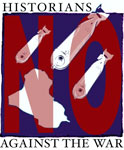Neomedievalism, Neoconservatism and the War on Terror
An August 26, 2008 the French Committee of Vigilance on the Public Uses of History (CVUH) published Nicolas Hoffenstad's review of Bruce Holsinger's Neomedievalism, Neoconservatism and the War on Terror (Prickly Press, 2007). (http://cvuh.free.fr/spip.php?article195).
As we try to understand the wars in Iraq and Afghanistan, it is a worthwhile read. Those who teach Medieval History and Western Civilization as well as those who are concerned with rhetorical manipulations, deceptions, disruptions and wish to make them a part of critical historical teaching will find Holsinger's book informed, informative and useful.
The publisher's synopsis states,
"President Bush was roundly criticized for likening America’s antiterrorism measures to a “crusade” in 2001. Far from just a gaffe, however, such medievalism has become a dominant paradigm for comprehending the identity and motivations of America’s perceived enemy in the war on terror. Yet as Bruce Holsinger argues here, this cloying post-9/11 rhetoric has served to obscure the more intricate ideological machinations of neomedievalism, the global idiom of the non-state actor: non-governmental organizations, transnational corporate militias, and terrorist organizations such as al Qaeda.
Neomedievalism, Neoconservatism, and the War on Terror addresses the role of neomedievalism in contemporary politics. While international-relations theorists promote neomedievalism as a model for understanding emergent modes of global sovereignty, neoconservatives exploit its conceptual slipperiness for their own tactical ends. Holsinger concludes with a careful parsing of the Bush administration’s torture memos, which enlist neomedievalism’s model of feudal sovereignty on behalf of the abrogation of human rights. President Bush was roundly criticized for likening America’s antiterrorism measures to a “crusade” in 2001. Far from just a gaffe, however, such medievalism has become a dominant paradigm for comprehending the identity and motivations of America’s perceived enemy in the war on terror.
See: http://www.press.uchicago.edu/presssite/metadata.epl?mode=synopsis&bookkey=229378
As we try to understand the wars in Iraq and Afghanistan, it is a worthwhile read. Those who teach Medieval History and Western Civilization as well as those who are concerned with rhetorical manipulations, deceptions, disruptions and wish to make them a part of critical historical teaching will find Holsinger's book informed, informative and useful.
The publisher's synopsis states,
"President Bush was roundly criticized for likening America’s antiterrorism measures to a “crusade” in 2001. Far from just a gaffe, however, such medievalism has become a dominant paradigm for comprehending the identity and motivations of America’s perceived enemy in the war on terror. Yet as Bruce Holsinger argues here, this cloying post-9/11 rhetoric has served to obscure the more intricate ideological machinations of neomedievalism, the global idiom of the non-state actor: non-governmental organizations, transnational corporate militias, and terrorist organizations such as al Qaeda.
Neomedievalism, Neoconservatism, and the War on Terror addresses the role of neomedievalism in contemporary politics. While international-relations theorists promote neomedievalism as a model for understanding emergent modes of global sovereignty, neoconservatives exploit its conceptual slipperiness for their own tactical ends. Holsinger concludes with a careful parsing of the Bush administration’s torture memos, which enlist neomedievalism’s model of feudal sovereignty on behalf of the abrogation of human rights. President Bush was roundly criticized for likening America’s antiterrorism measures to a “crusade” in 2001. Far from just a gaffe, however, such medievalism has become a dominant paradigm for comprehending the identity and motivations of America’s perceived enemy in the war on terror.
See: http://www.press.uchicago.edu/presssite/metadata.epl?mode=synopsis&bookkey=229378
Hope all are energized by new opportunities to engage one another and our students.


0 Comments:
Post a Comment
<< Home